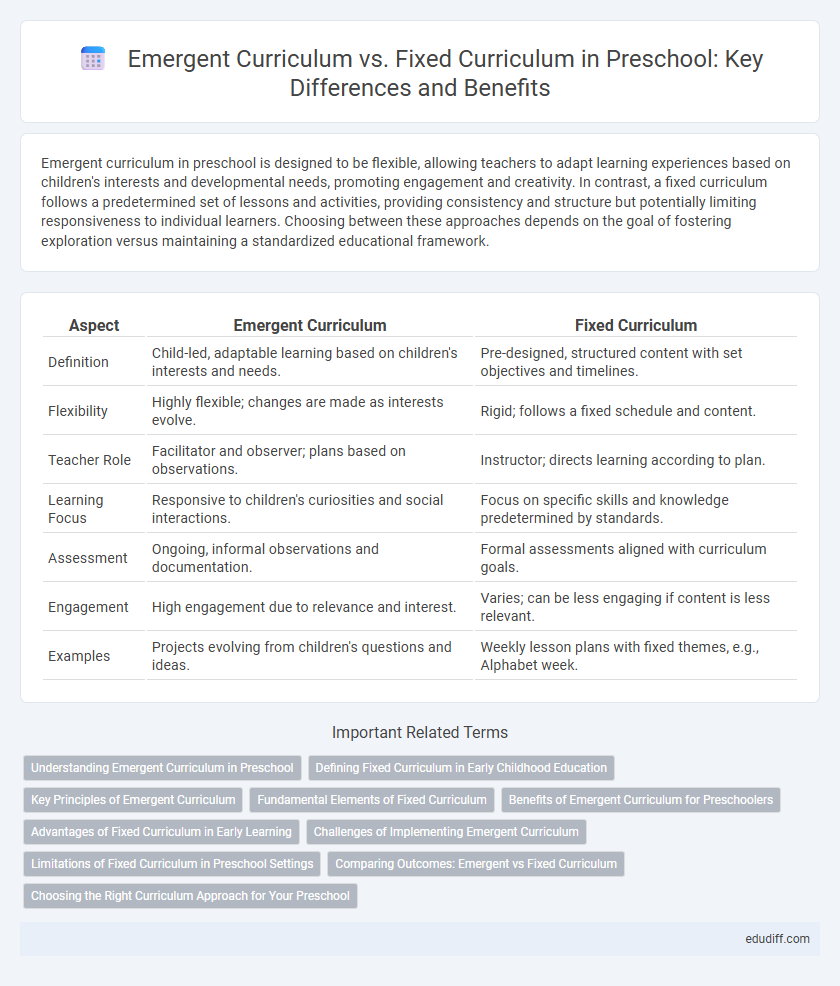Emergent curriculum in preschool is designed to be flexible, allowing teachers to adapt learning experiences based on children's interests and developmental needs, promoting engagement and creativity. In contrast, a fixed curriculum follows a predetermined set of lessons and activities, providing consistency and structure but potentially limiting responsiveness to individual learners. Choosing between these approaches depends on the goal of fostering exploration versus maintaining a standardized educational framework.
Table of Comparison
| Aspect | Emergent Curriculum | Fixed Curriculum |
|---|---|---|
| Definition | Child-led, adaptable learning based on children's interests and needs. | Pre-designed, structured content with set objectives and timelines. |
| Flexibility | Highly flexible; changes are made as interests evolve. | Rigid; follows a fixed schedule and content. |
| Teacher Role | Facilitator and observer; plans based on observations. | Instructor; directs learning according to plan. |
| Learning Focus | Responsive to children's curiosities and social interactions. | Focus on specific skills and knowledge predetermined by standards. |
| Assessment | Ongoing, informal observations and documentation. | Formal assessments aligned with curriculum goals. |
| Engagement | High engagement due to relevance and interest. | Varies; can be less engaging if content is less relevant. |
| Examples | Projects evolving from children's questions and ideas. | Weekly lesson plans with fixed themes, e.g., Alphabet week. |
Understanding Emergent Curriculum in Preschool
Emergent curriculum in preschool emphasizes child-led learning by observing children's interests and adapting activities to foster creativity, critical thinking, and engagement. Unlike fixed curriculum, which follows predetermined goals and schedules, emergent curriculum allows flexibility to support developmentally appropriate experiences tailored to each child's needs. This approach cultivates a dynamic and responsive educational environment promoting intrinsic motivation and deeper understanding.
Defining Fixed Curriculum in Early Childhood Education
Fixed curriculum in early childhood education refers to a structured, predetermined set of learning objectives and activities designed to be consistently followed across classrooms and time periods. This approach emphasizes standardized content delivery, ensuring all children receive the same educational experiences and outcomes. It contrasts with emergent curriculum, which adapts to children's interests and developmental needs, focusing instead on uniformity and stability in teaching methods and materials.
Key Principles of Emergent Curriculum
Emergent curriculum emphasizes responsiveness to children's interests, promoting active exploration and meaningful learning experiences tailored to their developmental stages. Key principles include flexibility, child-centered planning, and observation-driven instruction that adapts to evolving classroom dynamics. This approach fosters engagement, creativity, and critical thinking by integrating real-life contexts and student input into the educational process.
Fundamental Elements of Fixed Curriculum
A fixed curriculum in preschool emphasizes structured lesson plans, standardized learning objectives, and consistent assessment criteria to ensure uniform educational outcomes. Core components include predetermined content delivery, sequenced skill development, and teacher-led instruction designed to meet specific academic standards. This approach prioritizes consistency, predictability, and alignment with established educational benchmarks for early childhood development.
Benefits of Emergent Curriculum for Preschoolers
Emergent curriculum in preschool promotes child-centered learning by adapting activities to children's interests and developmental stages, enhancing engagement and motivation. This approach fosters critical thinking and creativity by encouraging exploration and problem-solving within real-life contexts. It also supports social-emotional growth through collaborative projects and responsive interactions, leading to a more holistic development compared to a fixed curriculum.
Advantages of Fixed Curriculum in Early Learning
A fixed curriculum in early learning provides structured consistency that supports developmental milestones and ensures comprehensive coverage of foundational skills. It facilitates easier assessment and progress tracking for educators by maintaining uniform objectives across all learners. This approach also helps establish clear expectations for children, fostering a stable and predictable classroom environment conducive to focused learning.
Challenges of Implementing Emergent Curriculum
Implementing an emergent curriculum in preschool presents challenges such as the need for constant observation and documentation to tailor activities to children's interests, which demands significant time and expertise from educators. Unlike fixed curricula with predetermined lesson plans, emergent curriculum requires flexibility and responsiveness, making consistency and assessment more complex. Balancing child-led exploration with developmental benchmarks often creates difficulties in meeting standardized educational requirements.
Limitations of Fixed Curriculum in Preschool Settings
Fixed curriculum in preschool settings often restricts the ability to respond to children's individual interests and developmental stages, limiting personalized learning opportunities. It can stifle creativity and fail to accommodate diverse cultural backgrounds and learning paces. Such rigidity may result in disengagement and hinder the holistic growth essential for early childhood education.
Comparing Outcomes: Emergent vs Fixed Curriculum
Emergent curriculum fosters child-centered learning by adapting to children's interests, promoting creativity, critical thinking, and social-emotional growth, whereas fixed curriculum follows a predetermined structure emphasizing standardized skill acquisition and academic milestones. Studies indicate emergent curriculum enhances engagement and intrinsic motivation, resulting in higher retention of concepts and improved problem-solving abilities compared to fixed curriculums. Fixed curriculum often ensures uniform developmental benchmarks but may limit flexibility and responsiveness to individual learning styles in early childhood education.
Choosing the Right Curriculum Approach for Your Preschool
Selecting the right curriculum approach for your preschool involves evaluating whether an emergent curriculum or a fixed curriculum better supports your educational goals and children's developmental needs. Emergent curriculum emphasizes child-led learning based on interests and experiences, fostering creativity and critical thinking, while a fixed curriculum offers structured, predetermined lesson plans ensuring consistency and clear learning outcomes. Consider your preschool's philosophy, teacher expertise, and diversity of learners to balance flexibility with structure for optimal early childhood education.
Emergent curriculum vs Fixed curriculum Infographic

 edudiff.com
edudiff.com